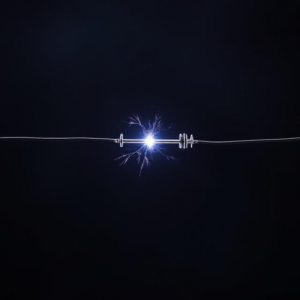1. Scalar Product (Dot Product)
-
- The scalar product (also known as the dot product) is a way of multiplying two vectors that results in a scalar (a number, not a vector).
- It tells you how much one vector goes in the direction of another. In simpler terms, it’s about how much one vector “overlaps” or “projects” onto another vector.

- Formula:
Where:
and
are two vectors.
and
are the magnitudes (lengths) of the vectors
and
.
is the angle between the two vectors.
- Explanation:
- If the angle
between the two vectors is 0° (they are pointing in the same direction), the dot product is maximum.
- If the angle
is 90° (the vectors are at right angles to each other), the dot product is zero (because
).
- The result is always a scalar (just a number).
- If the angle
- Example:
- Imagine you’re pushing a sled with a force vector
, and the direction of the sled’s motion is represented by another vector
. The dot product will tell you how much of the pushing force is actually helping to move the sled in the direction of its motion. If the angle between
and
is 0°, the entire force is used in the movement; if it’s 90°, none of the force contributes to the motion.
- Imagine you’re pushing a sled with a force vector
2. Vector Product (Cross Product)
-
- The vector product (also known as the cross product) is another way to multiply two vectors. Unlike the dot product, the result of a cross product is a vector, not a scalar.
- It tells you about the perpendicular direction of the two vectors. This product gives a vector that is perpendicular (at a right angle) to both of the original vectors.
- Formula:
Where:
and
are the two vectors.
and
are the magnitudes (lengths) of the vectors.
is the angle between the two vectors.
is the unit vector perpendicular to both
and
, pointing in a specific direction determined by the right-hand rule.
- Explanation:
- The magnitude of the result vector is given by
, so the cross product is largest when the vectors are at 90° to each other.
- The direction of the resulting vector is determined using the right-hand rule: If you curl the fingers of your right hand from
to
, your thumb points in the direction of the cross product.
- The result of a cross product is always a vector that is perpendicular to both of the original vectors.
- The magnitude of the result vector is given by
- Example:
- Think of a force applied to a lever. The torque (rotational force) is given by the cross product of the force vector and the lever arm vector. The direction of the torque vector is perpendicular to the plane formed by the force and the lever arm.
Key Differences between Scalar and Vector Products:
| Feature | Scalar Product (Dot Product) | Vector Product (Cross Product) |
|---|---|---|
| Result | Scalar (number) | Vector |
| Formula |
|
|
| Resulting Direction | No direction, only magnitude | Perpendicular to both vectors |
| When Is It Zero? | When vectors are perpendicular (
) |
When vectors are parallel or antiparallel (
or ) |
| Use Case | Finding how much one vector goes in the direction of another | Finding a vector perpendicular to the two vectors, e.g., torque, magnetic force |
Real-life Examples:
- Dot Product (Scalar Product):
- Work done by a force: If you apply a force to an object, and the object moves, the work done is a dot product of the force vector and the displacement vector.
- If the force is applied in the same direction as the displacement, the work is maximum. If the force is at 90° to the direction of motion, no work is done.
- Work done by a force: If you apply a force to an object, and the object moves, the work done is a dot product of the force vector and the displacement vector.
- Cross Product (Vector Product):
- Torque: When you apply a force to a lever, the torque is calculated using the cross product of the force and the distance from the pivot point.
- The direction of the torque vector tells you the axis of rotation, and the magnitude gives you the strength of the rotational force.
- Torque: When you apply a force to a lever, the torque is calculated using the cross product of the force and the distance from the pivot point.
Summary:
- Scalar Product (Dot Product) results in a scalar number and tells you about how much two vectors align in the same direction.
- Vector Product (Cross Product) results in a vector and tells you about the perpendicular direction to both original vectors, such as torque or rotational forces.











